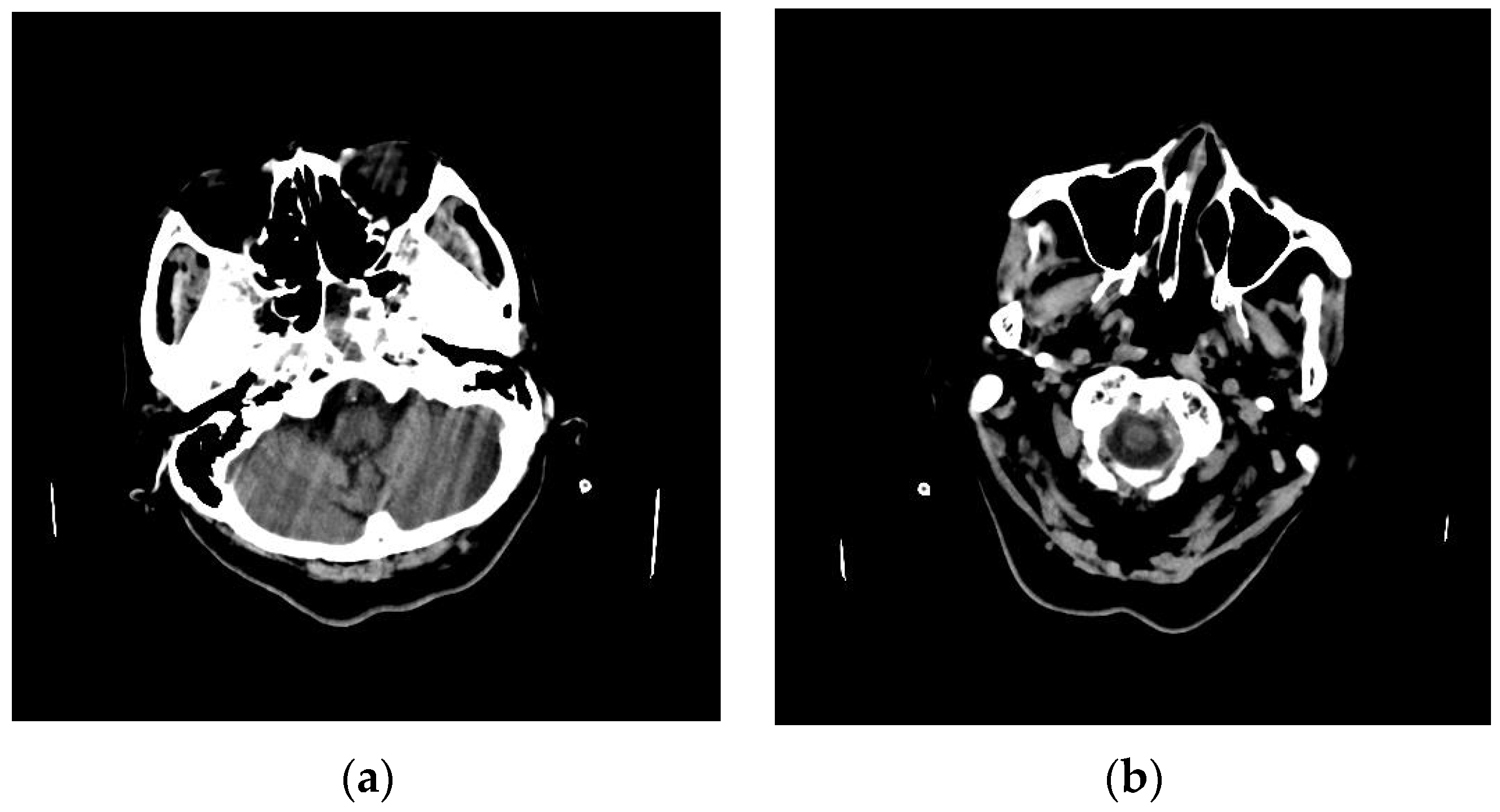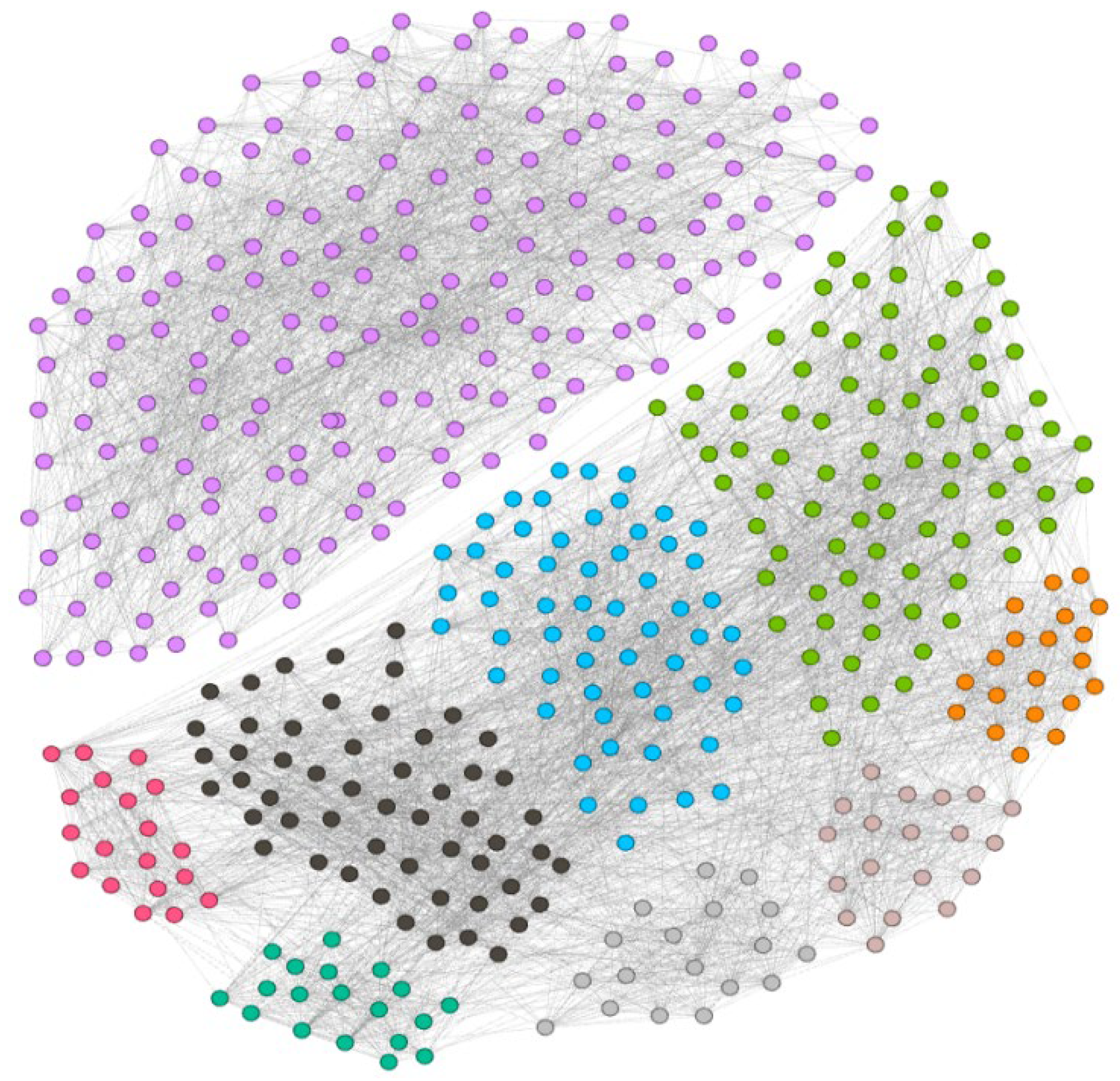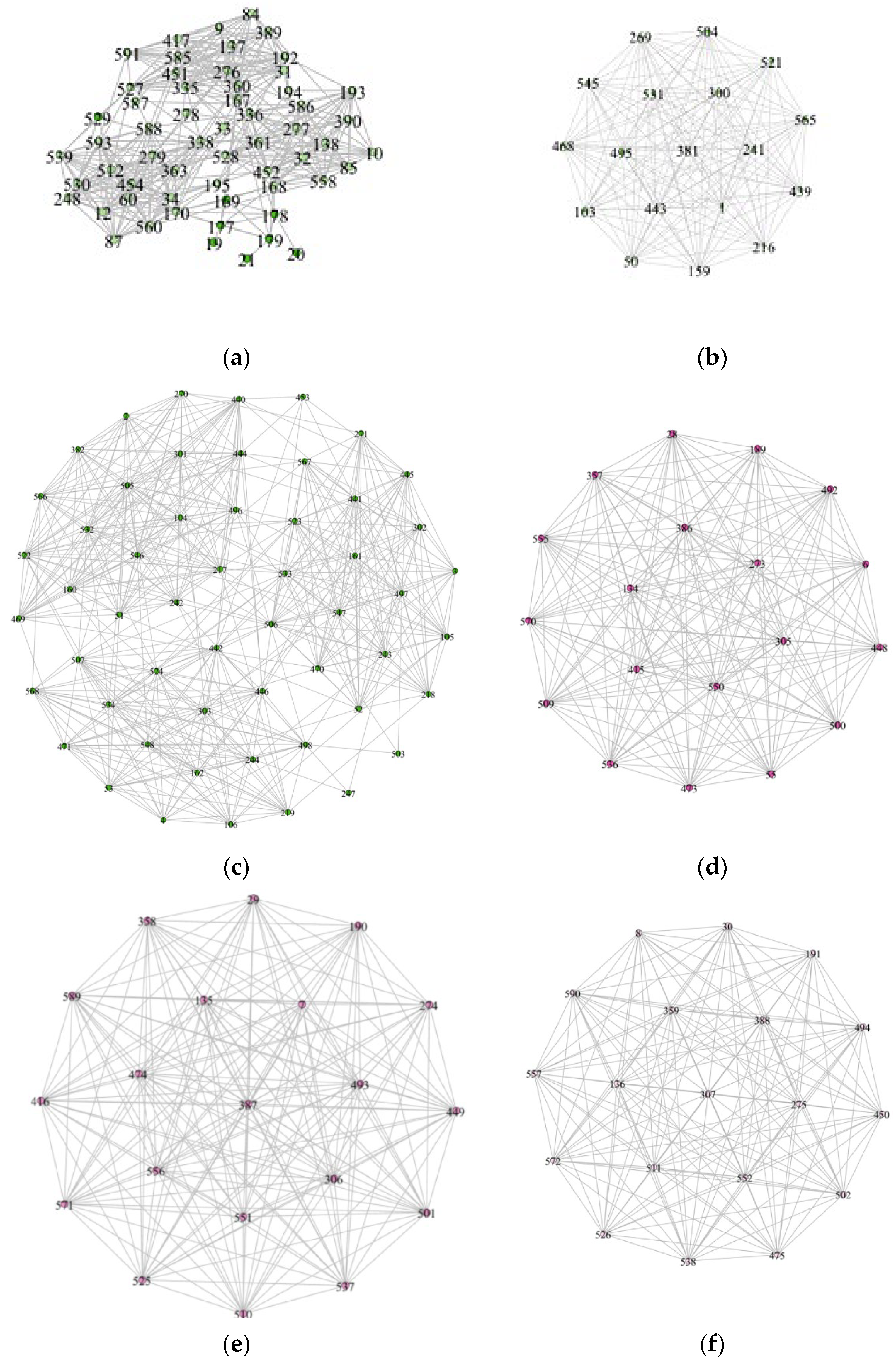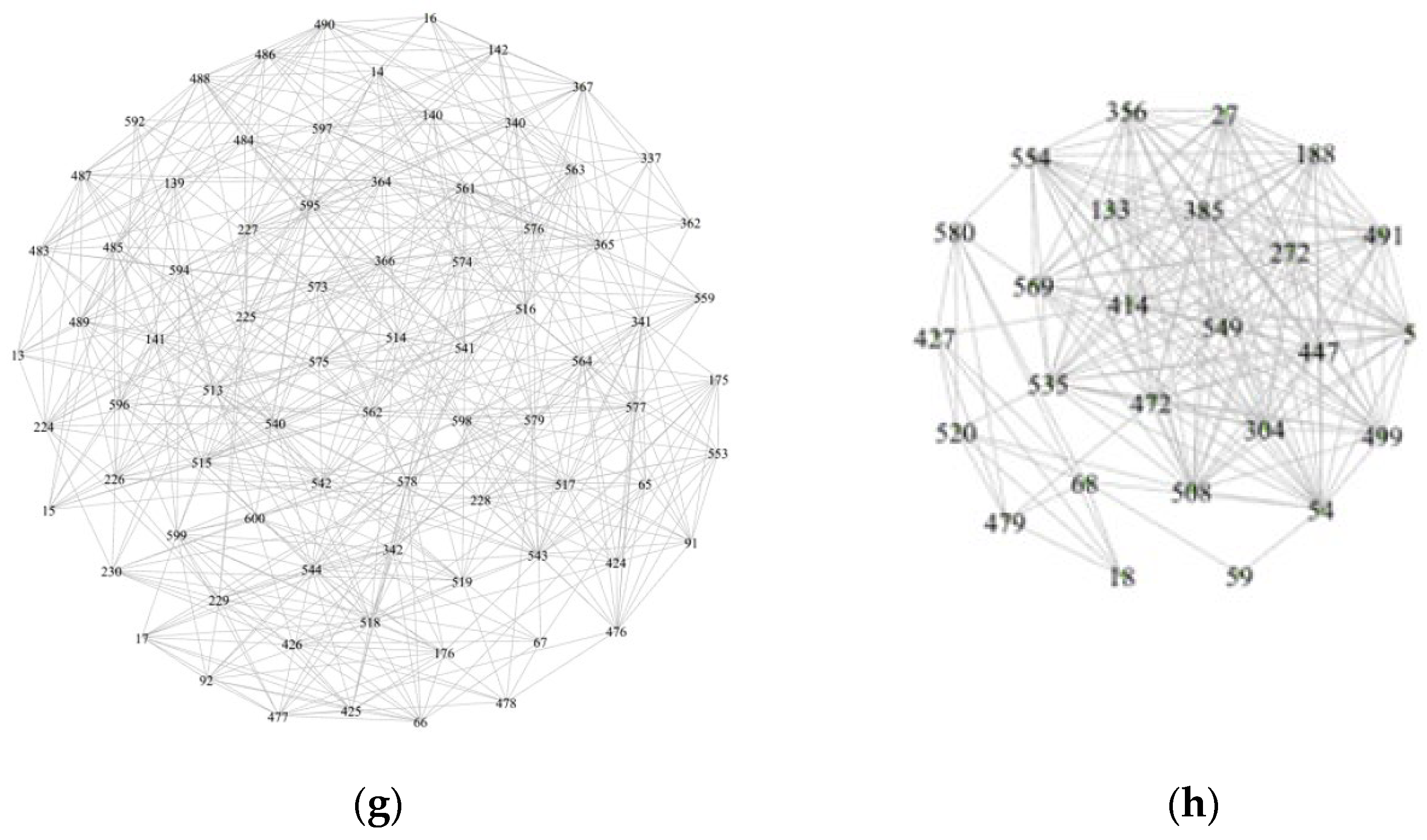Motion Artifact Detection Based on Regional–Temporal Graph Attention Network from Head Computed Tomography Images
Abstract
1. Introduction
2. Materials and Methods
2.1. Basic Notations and Problem Statement
2.2. Pipeline of the Proposed RT-GAT Method
2.2.1. Graph Construction
2.2.2. Graph Attention Network
2.2.3. Motion Artifact Detection Evaluation
3. Results
3.1. Dataset
3.2. Performance Metrics
4. Discussion
Author Contributions
Funding
Data Availability Statement
Conflicts of Interest
References
- Boas, F.E.; Fleischmann, D. CT artifacts: Causes and reduction techniques. Imaging Med. 2012, 4, 229–240. [Google Scholar] [CrossRef]
- Fair, D.; Miranda-Dominguez, O.; Snyder, A.; Perrone, A.; Earl, E.; Van, A.N.; Koller, J.M.; Feczko, E.; Tisdall, M.D.; van der Kouwe, A.; et al. Correction of respiratory artifacts in MRI head motion estimates. NeuroImage 2020, 208, 116400. [Google Scholar] [CrossRef] [PubMed]
- Power, J.; Mitra, A.; Laumann, T.; Snyder, A.; Schlaggar, B.; Petersen, S. Methods to detect, characterize, and remove motion artifact in resting state fMRI. NeuroImage 2014, 84, 320–341. [Google Scholar] [CrossRef] [PubMed]
- Doi, K. Computer-aided diagnosis in medical imaging: Historical review, current status and future potential. Comput. Med. Imaging Graph. 2007, 31, 198–211. [Google Scholar] [CrossRef]
- Spin-Neto, R.; Kruse, C.; Hermann, L.; Kirkevang, L.L.; Wenzel, A. Impact of motion artefacts and motion-artefact correction on diagnostic accuracy of apical periodontitis in CBCT images: An ex vivo study in human cadavers. Int. Endod. J. 2020, 53, 1275. [Google Scholar] [CrossRef]
- Wei, L.; Rosen, B.; Vallières, M.; Chotchutipan, T.; Mierzwa, M.; Eisbruch, A.; El Naqa, I. Automatic recognition and analysis of metal streak artifacts in head and neck computed tomography for radiomics modeling. Phys. Imaging Radiat. Oncol. 2019, 10, 49–54. [Google Scholar] [CrossRef]
- Ger, R.B.; Craft, D.F.; Mackin, D.S.; Zhou, S.; Layman, R.R.; Jones, A.K.; Elhalawani, H.; Fuller, C.D.; Howell, R.M.; Li, H.; et al. Practical guidelines for handling head and neck computed tomography artifacts for quantitative image analysis. Comput. Med. Imaging Graph. 2018, 69, 134–139. [Google Scholar] [CrossRef]
- Stoeve, M.P.; Aubreville, M.; Oetter, N.; Knipfer, C.; Neumann, H.; Stelzle, F.; Maier, A. Motion Artifact Detection in Confocal Laser Endomicroscopy Images; Springer: Berlin/Heidelberg, Germany, 2017. [Google Scholar]
- Wallner, J.; Mischak, I.; Egger, J. Computed tomography data collection of the complete human mandible and valid clinical ground truth models. Sci. Data 2019, 6, 190003. [Google Scholar] [CrossRef]
- Hamilton, W.L. Graph Representation Learning. In Synthesis Lectures on Artificial Intelligence and Machine Learning; Claypool Publishers: San Rafael, CA, USA, 2020; Volume 14, pp. 1–159. [Google Scholar]
- Krizhevsky, A.; Sulskever, I.; Hinton, G.E. ImageNet classification with deep convolutional neural networks. Adv. Neural Inf. Process. Syst. 2012, 60, 84–90. [Google Scholar] [CrossRef]
- Graham, M.S.; Ivana, D.; Hui, Z. A supervised learning approach for diffusion MRI quality control with minimal training data. Neuroimage 2018, 178, 668–676. [Google Scholar] [CrossRef]
- Zaitsev, M.; Maclaren, J.; Herbst, M. Motion artifacts in MRI: A complex problem with many partial solutions. J. Magn. Reson. Imaging 2015, 42, 887–901. [Google Scholar] [CrossRef] [PubMed]
- Locatello, F.; Bauer, S.; Lui, M.; Rtsch, G.; Gelly, S.; Schlkopf, B.; Bachem, O. Challenging Common Assumptions in the Unsupervised Learning of Disentangled Representations. In Proceedings of the 36th International Conference on Machine Learning, PMLR, Long Beach, CA, USA, 9–15 June 2019. [Google Scholar]
- Hernandez, S.; Sjogreen, C.; Gay, S.S.; Nguyen, C.; Cardenas, C.E. Development and dosimetric assessment of an automatic dental artifact classification tool to guide artifact management techniques in a fully automated treatment planning workflow. Comput. Med. Imaging Graph. 2021, 90, 101907. [Google Scholar] [CrossRef] [PubMed]
- Wei, Y.; Xia, W.; Lin, M.; Huang, J.; Ni, B.; Dong, J.; Zhao, Y.; Yan, S. Hcp: A flexible CNN framework for multi-label image classification. IEEE Trans. Pattern Anal. Mach. Intell. 2016, 38, 1901–1907. [Google Scholar] [CrossRef] [PubMed]
- Welch, M.L.; Mcintosh, C.; Traverso, A.; Wee, L.; Jaffray, D.A. External validation and transfer learning of convolutional neural networks for computed tomography dental artifact classification. Phys. Med. Biol. 2019, 65, 035017. [Google Scholar] [CrossRef]
- Albert, R.; Barabási, A.L. Statistical mechanics of complex networks. Rev. Mod. Phys. 2002, 74, 47–97. [Google Scholar] [CrossRef]
- Barabási, A.L.; Albert, R. Emergence of scaling in random networks. Science 1999, 286, 509–512. [Google Scholar] [CrossRef]
- Watts, D.J.; Strogatz, S.H. Collective dynamics of ‘small-world’ networks. Nature 1998, 393, 440–442. [Google Scholar] [CrossRef]
- Costa, L.D.F.; Oliveira, O.N., Jr.; Travieso, G.; Rodrigues, F.A.; Villas Boas, P.R.; Antiqueira, L.; Viana, M.P.; Correa Rocha, L.E. Analyzing and modeling real-world phenomena with complex networks: A survey of applications. Adv. Phys. 2011, 60, 329–412. [Google Scholar] [CrossRef]
- Zhou, J.; Cui, G.; Hu, S.; Zhang, Z.; Yang, C.; Liu, Z.; Wang, L.; Li, C.; Sun, M. Graph neural networks: A review of methods and applications. AI Open 2020, 1, 57–81. [Google Scholar] [CrossRef]
- Garlaschelli, D.; Battiston, S.; Castri, M.; Servedio, V.D.P.; Caldarelli, G. The scale-free topology of market investments. Phys. A Stat. Mech. Appl. 2005, 350, 491–499. [Google Scholar] [CrossRef]
- Borgatti, S.; Mehra, A.; Brass, D.J.; Labianca, G. Network Analysis in the Social Science. Science 2009, 323, 892–895. [Google Scholar] [CrossRef]
- Li, H.; Zhao, H.; Cai, W.; Xu, J.Q.; Ai, J. A modular attachment mechanism for software network evolution. Phys. A Stat. Mech. Appl. 2013, 392, 2025–2037. [Google Scholar] [CrossRef]
- Machado, B.B.; Scabini, L.F.; Margarido Orue, J.P.; De Arruda, M.S.; Goncalves, D.N.; Goncalves, W.N.; Moreira, R.; Rodrigues, J.F., Jr. A complex network approach for nanoparticle agglomeration analysis in nanoscale images. J. Nanopart. Res. 2017, 19, 65. [Google Scholar] [CrossRef]
- Backes, A.R.; Casanova, D.; Bruno, O.M. Texture analysis and classification: A complex network-based approach. Inf. Sci. 2013, 219, 168–180. [Google Scholar] [CrossRef]
- Ribas, L.C.; Riad, R.; Jennane, R.; Bruno, O.M. A complex network based approach for knee osteoarthritis detection: Data from the osteoarthritis initiative. Biomed. Signal Process. Control 2022, 71, 103133. [Google Scholar] [CrossRef]
- Xu, S.S.; Duan, L.H.; Zhang, Y.; Zhang, Z.C.; Sun, T.S.; Tian, L.X. Graph- and transformer-guided boundary aware network for medical image segmentation. Comput. Methods Programs Biomed. 2023, 242, 107849. [Google Scholar] [CrossRef]
- Abe, S.; Suzuki, N. Dynamical evolution of the community structure of complex earthquake network. EPL 2012, 99, 313–316. [Google Scholar] [CrossRef]
- Wein, S.; Malloni, W.; Tomé, A.M.; Frank, S.M.; Lang, E.W. A graph neural network framework for causal inference in brain networks. Sci. Rep. 2021, 11, 8061. [Google Scholar] [CrossRef] [PubMed]
- Yang, Z.; Wu, Q.; Zhang, F.; Chen, X.; Wang, W.; Zhang, X.S. Optimizing spatial relationships in gcn to improve the classification accuracy of remote sensing images. Intell. Autom. Soft Comput. 2023, 37, 491–506. [Google Scholar] [CrossRef]
- Ghorbani, M.; Kazi, A.; Baghshah, M.S.; Rabiee, H.R.; Navab, N. RA-GCN: Graph convolutional network for disease prediction problems with imbalanced data. Med. Image Anal. 2022, 75, 102272. [Google Scholar] [CrossRef] [PubMed]
- Hong, D.; Gao, L.; Yao, J.; Zhang, B.; Plaza, A.; Chanussot, J. Graph convolutional networks for hyperspectral image classification. IEEE Trans. Geosci. Remote Sens. 2021, 59, 5966–5978. [Google Scholar] [CrossRef]
- Mao, C.; Yao, L.; Luo, Y. ImageGCN: Multi-relational image graph convolutional networks for disease identification with chest X-rays. IEEE Trans. Med. Imaging 2022, 41, 1990–2003. [Google Scholar] [CrossRef]
- Al Arif, S.M.; Masudur, R.; Knapp, K.; Slabaugh, G. Fully Automatic Cervical Vertebrae Segmentation Framework for X-ray Images. Comput. Methods Programs Biomed. 2018, 157, 95–111. [Google Scholar] [CrossRef]
- Lee, H.M.; Kim, Y.J.; Kim, K.G. Segmentation Performance Comparison Considering Regional Characteristics in Chest X-ray Using Deep Learning. Sensors 2022, 22, 3143. [Google Scholar] [CrossRef]
- Pollreisz, D.; Taherinejad, N. Detection and Removal of Motion Artifacts in PPG Signals. Mob. Netw. Appl. 2022, 27, 728–738. [Google Scholar] [CrossRef]
- Hossain, M.B.; Posada-Quintero, H.F.; Kong, Y.; Mcnaboe, R.; Chon, K.H. Automatic motion artifact detection in electrodermal activity data using machine learning. Biomed. Signal Process. Control 2022, 74, 103483. [Google Scholar] [CrossRef]
- Zhang, Q.M.; Shang, M.S.; Lu, L. Similarity-based classification in partially labeled networks. Int. J. Mod. Phys. C 2010, 21, 813. [Google Scholar] [CrossRef]
- Da Costa, L.F.; Rodrigues, F.A.; Travieso, G.; Villas-Boas, P.R. Characterization of complex networks: A survey of measurements. Adv. Phys. 2007, 56, 167–242. [Google Scholar] [CrossRef]
- Stam, C.J. Characterization of anatomical and functional connectivity in the brain: A complex networks perspective. Int. J. Psychophysiol. 2010, 77, 186–194. [Google Scholar] [CrossRef] [PubMed]
- Marchette, D.J. Random Graphs for Statistical Pattern Recognition; Wiley-Interscience: Hoboken, NJ, USA, 2005. [Google Scholar]
- Chalumeau, T.; Costa, L.D.F.; Laligant, O.; Meriaudeau, F. Optimized texture classification by using hierarchical complex network measurements. In Machine Vision Applications in Industrial Inspection XIV; SPIE: Bellingham, WA, USA, 2006. [Google Scholar]
- Backes, A.R.; Bruno, O.M. A graph-based approach for shape skeleton analysis. In Lecture Notes in Computer Science; Springer: Berlin/Heidelberg, Germany, 2009; Volume 5716. [Google Scholar]
- Antiqueira, L.; Nunes, M.D.G.V.; Oliveira, O.N., Jr.; Costa, L.D.F. Strong correlations between text quality and complex networks features. Phys. A 2007, 373, 811–820. [Google Scholar] [CrossRef]
- Barrett, J.F.; Keat, N. Artifacts in CT: Recognition and avoidance. Radiographics 2004, 24, 1679–1691. [Google Scholar] [CrossRef] [PubMed]
- De Crop, A.; Casselman, J.; Van Hoof, T.; Dierens, M.; Vereecke, E.; Bossu, N.; Pamplona, J.; D’Herde, K.; Thierens, H.; Bacher, K. Analysis of metal artifact reduction tools for dental hardware in CT scans of the oral cavity: kVp, iterative reconstruction, dual-energy CT, metal artifact reduction software: Does it make a difference? Neuroradiology 2015, 57, 841–849. [Google Scholar] [CrossRef] [PubMed]
- Liu, Y.; Wen, T.; Sun, W.; Liu, Z.; Song, X.; He, X.; Zhang, S.; Wu, Z. Graph-Based Motion Artifacts Detection Method from Head Computed Tomography Images. Sensors 2022, 22, 5666. [Google Scholar] [CrossRef] [PubMed]






| Predicted | |||
|---|---|---|---|
| 1 | 0 | ||
| True | 1 | True Positive (TP) | False Negative (FN) |
| False | 0 | False Positive (FP) | True Negative (TN) |
| Sensitivity | Accuracy | Specificity | |
|---|---|---|---|
| CNN | 85.67% | 78.67% | 71.67% |
| GLCM + RF | 87.00% | 88.00% | 89.00% |
| GLCM + SVM | 86.00% | 88.00% | 93.00% |
| GCN | 89.1% | 90.3% | 88.5% |
| GAT | 89.5% | 90.8% | 87.2% |
| RT-GAT | 90.7% | 92.3% | 89.1% |
| Region-Level Global Information | Pixel-Level Local Information | Topological Features | Regional–Temporal Information | Attention Mechanism | |
|---|---|---|---|---|---|
| CNN | × | √ | × | × | × |
| GLCM + SVM | × | √ | × | × | × |
| GLCM + RF | × | √ | × | × | × |
| GCN | √ | √ | √ | × | × |
| GAT | √ | √ | √ | × | √ |
| RT-GAT | √ | √ | √ | √ | √ |
Disclaimer/Publisher’s Note: The statements, opinions and data contained in all publications are solely those of the individual author(s) and contributor(s) and not of MDPI and/or the editor(s). MDPI and/or the editor(s) disclaim responsibility for any injury to people or property resulting from any ideas, methods, instructions or products referred to in the content. |
© 2024 by the authors. Licensee MDPI, Basel, Switzerland. This article is an open access article distributed under the terms and conditions of the Creative Commons Attribution (CC BY) license (https://creativecommons.org/licenses/by/4.0/).
Share and Cite
Liu, Y.; Wen, T.; Wu, Z. Motion Artifact Detection Based on Regional–Temporal Graph Attention Network from Head Computed Tomography Images. Electronics 2024, 13, 724. https://doi.org/10.3390/electronics13040724
Liu Y, Wen T, Wu Z. Motion Artifact Detection Based on Regional–Temporal Graph Attention Network from Head Computed Tomography Images. Electronics. 2024; 13(4):724. https://doi.org/10.3390/electronics13040724
Chicago/Turabian StyleLiu, Yiwen, Tao Wen, and Zhenning Wu. 2024. "Motion Artifact Detection Based on Regional–Temporal Graph Attention Network from Head Computed Tomography Images" Electronics 13, no. 4: 724. https://doi.org/10.3390/electronics13040724
APA StyleLiu, Y., Wen, T., & Wu, Z. (2024). Motion Artifact Detection Based on Regional–Temporal Graph Attention Network from Head Computed Tomography Images. Electronics, 13(4), 724. https://doi.org/10.3390/electronics13040724





